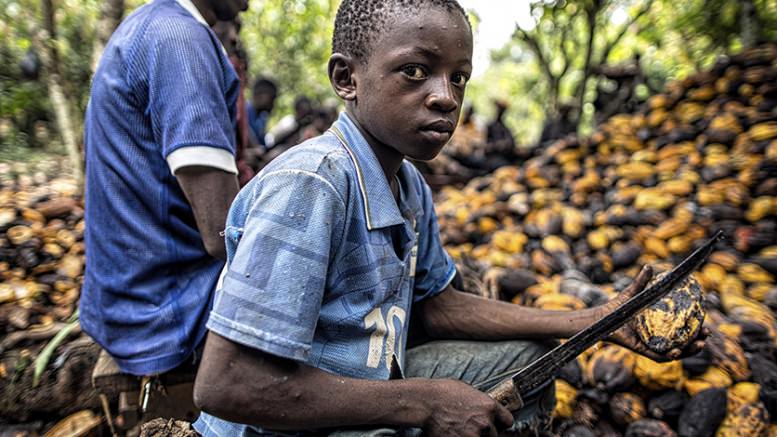For a decade and a half, the big chocolate makers have promised to end child labor in their industry—and have spent tens of millions of dollars in the effort. But as of the latest estimate, 2.1 million West African children still do the dangerous and physically taxing work of harvesting cocoa. What will it take to fix the problem?
The boy with the machete is watching us. We’re sitting in an SUV in the middle of a rugged, red-dirt road about 10 miles outside the city of Abengourou, in eastern Ivory Coast. It’s just after 8 a.m. on a Saturday, and the early morning haze hasn’t yet burned off, so a mist hangs over the fields around us. We’ve been slowly bumping along on our way to meet some farmers in a nearby village called Appoisso but stop for a moment to take in the scene. Suddenly the boy is standing right next to us. He looks curious, but wary too.
We scramble out to greet him. In French my translator asks him his name. “Ibrahim Traoré,” he replies. How old is he? “Fifteen.”
Ibrahim is wearing ripped jeans, a worn, royal-blue Chelsea soccer shirt with the name of the team’s sponsor—Samsung—in large white letters across the front, and the same kind of clear plastic sandals that are everywhere in this part of West Africa. He holds his dusty blade casually against his left hip.
There’s a sign behind him that appears to have been erected by the Ivorian government as part of a campaign to educate farmers about children’s rights. non it says in big, red letters. Then, again in French: “The worst forms of child labor.” Below that is a drawing of a young boy carrying a huge sack of cocoa beans with a big X over it. Underneath is another sentence: “The place for children is in school.”
Ibrahim tells us that he was born in Mali. He moved with his father to Ivory Coast when he was little—he’s not sure exactly how old he was—and he’s been working on cocoa farms ever since. What about school? No, he says, he’s never been to school. Is the work he does hard? “Yes,” he says deliberately. “It’s very hard.”
As we talk, a parade of younger boys, many holding machetes as well, walk by on their way to the fields. Ibrahim allows his eyes to follow them. After a few minutes he says it’s time for him to go and marches after the other children, the machete swinging loosely in his hand.
For the $100 billion chocolate candy industry, the story of Ibrahim represents a serious problem—one that it has been vowing to fix for 15 years without great success, and which has gained new urgency in recent months.
Child labor in West African cocoa farming first became a cause célèbre around the turn of the century when a number of pieces of investigative journalism focused the world’s attention on the plight of children who had been trafficked to Ivory Coast to farm cocoa, often from other former French colonies such as Mali and Burkina Faso, and held as slave laborers. In a documentary that aired on the BBC, filmmakers interviewed young boys in Ivory Coast who said they’d been beaten and forced to work long hours without pay. One who said he’d been working on a cocoa farm for five years was asked what he thought about people enjoying chocolate in other parts of the world. “They are enjoying something that I suffered to make,” the boy answered. “They are eating my flesh.”
 A boy in Ivory Coast carries a basket of freshly harvested cocoa seeds.
A boy in Ivory Coast carries a basket of freshly harvested cocoa seeds.
For shocked consumers in the U.S. and Europe, the revelation that the Kit Kat bars and M&M’s they were giving their kids for a treat might have been produced by boys and girls in Africa who’d been robbed of their childhoods was tough to swallow. Many channeled their guilt into outrage at the likes of Hershey
, Mars, Nestlé, and Cadbury.
 The main harvest season for cocoa is from October through December. When the yellow and orange pods are ripe…
The main harvest season for cocoa is from October through December. When the yellow and orange pods are ripe…
The multinational chocolate makers are heavily dependent on West Africa. More than 70% of the world’s cocoa is grown in the region, and the vast majority of that supply comes from two countries: Ivory Coast and Ghana, which together produce 60% of the global total. The two nations have a combined GDP of around $73 billion, according to the World Bank—or significantly less than Nestlé’s $100 billion in sales last year. Yet the global chocolate business would be thrown into chaos without them. Last year, Ivory Coast alone exported nearly 1.8 million metric tons of cocoa, or two-fifths of the world’s production. And demand for chocolate is going up, as a growing number of consumers in countries like China and India have more disposable income. The price of cocoa surged 13% in 2015 even as prices for most raw materials were dropping. Meanwhile the average farmer in each country still lives well below the international poverty line.
 …farmers cut them off trees with machetes or sickles. Workers break them apart…
…farmers cut them off trees with machetes or sickles. Workers break them apart…
The media coverage of child labor attracted the attention of U.S. politicians, who pressured the industry to tackle the issue. Former Sen. Tom Harkin, a Democrat of Iowa, and Rep. Eliot Engel, a New York Democrat, pushed the big chocolate makers to agree to eradicating the worst forms of child labor, as defined by the International Labor Organization’s Convention No. 182, by July 1, 2005. The deadline for meeting the goals of the Harkin-Engel Protocol was then pushed back to 2008, then 2010—and then it was really extended. The industry is now working on its pledge in 2010 to reduce child labor in Ivory Coast and Ghana by 70% by 2020.
 …to extract the gooey white seeds, , which are then piled up to ferment for a few days….
…to extract the gooey white seeds, , which are then piled up to ferment for a few days….
Though the most sensational stories about child labor over the years have focused on boys and girls who’ve been held against their will and abused, the more common story is similar to that of Ibrahim. Hundreds of thousands of children are used as free labor by their own families and often asked to take on dangerous tasks like harvesting with machetes or hauling 100-pound bags of beans. For many, school is not an option.
 Finally, the seeds are placed on drying racks. When dry, they’re ready to be exported and turned into chocolate.
Finally, the seeds are placed on drying racks. When dry, they’re ready to be exported and turned into chocolate.
There’s been a lot of activity on the corporate side in the years since the Harkin-Engel Protocol was signed, much of it in just the past couple of years. Virtually every name-brand chocolate maker has created or expanded its own sustainability program aimed at tackling the child labor issue by improving the lot of farmers—from Nestlé’s Cocoa Plan to Mondelez’s
Cocoa Life to Hershey’s 21st-Century Plan. And through the World Cocoa Foundation, an industry group, 10 of the largest chocolate companies created an ambitious program called CocoaAction in 2014. The plan, which has more than $500 million in funding, aims to reach 300,000 farmers in Ivory Coast and Ghana with training programs to help them boost productivity—under the assumption that healthier economics for farmers will translate to better conditions for their children.
Unfortunately, progress has been slow—and by some measures the problem has actually gotten worse in recent years. Last July the Payson Center for International Development at Tulane University released the findings of a comprehensive survey of child labor in Ivory Coast and Ghana in the 2013–14 growing season. The research was funded by the U.S. Department of Labor as part of ongoing follow-through on the Harkin-Engel Protocol and built on a previous survey conducted by Tulane five years earlier.
The conclusions were not what the chocolate industry or the governments of Ivory Coast and Ghana wanted to hear. Tulane found that 2.1 million children had been engaged in inappropriate forms of child labor in Ivory Coast and Ghana combined—a 21% increase over the 1.75 million identified in its survey five years earlier. Of those, 96% were found to be involved in “hazardous activity.” The number of children reported to be performing dangerous tasks fell by 6% in Ghana but jumped by 46% in Ivory Coast.
There was immediate blowback. A batch of headlines proclaimed that child slavery was on the rise. And in September three California consumers, represented by the same law firm, filed class-action lawsuits against Hershey, Mars, and Nestlé, claiming they wouldn’t have bought the products had they known the candy might be tainted by child labor.
Then, this February, the issue returned to the spotlight when the Supreme Court declined to consider whether to overturn a 2005 lawsuit brought against Nestlé, cocoa supplier Cargill, and Archer Daniels Midland (which got out of the cocoa business last year) on behalf of three unnamed boys who claim to have been trafficked to Ivory Coast and held as slaves. That cleared the way for the case to continue its slow progress toward a possible trial.
A Nestlé spokesperson says the company “looks forward to those proceedings in the lower courts and believes very strongly that the law and facts are on our side.”
Infographic by Nicolas Rapp
In a long statement to Fortune, a Cargill representative said that while the company is disappointed the Supreme Court chose not to review the case, it “believes strongly that this lawsuit is without merit.” ADM, which sold its cocoa and chocolate businesses to Olam and Cargill, respectively, in 2015, said it believes the lawsuit is “legally and factually meritless” and that it has a “strong defense and plan to vigorously defend the claims in court.”
As for the recent California class actions, the chocolate makers seem equally unruffled. Nestlé calls the suit against it meritless. Hershey did not address the specifics of the case but said it has “no tolerance for illegal practices, including children used as forced labor in cocoa farming.” Mars did not respond to our request for comment.
Despite the swirl of negative press, the chocolate industry argues that real gains are being made, and that the long lag time in producing results is understandable given the nature of the challenge. “I think your main question is, ‘Why is this hard to fix?’ ” says Nick Weatherill, executive director of the International Cocoa Initiative, a Geneva-based nonprofit funded by major chocolate makers that focuses on addressing child labor in cocoa in West Africa. “It is clearly a complex problem that has its roots in poverty, and rural poverty no less. And if the problem is rooted in poverty, then the solution, in a way, is as complex as poverty eradication. And in the grand scheme of things, you know, 15 years on a journey of poverty eradication isn’t actually that long.”
Engel, who sees both “reasons to be encouraged and to be disappointed,” doesn’t disagree. On the positive side, he points to a rise in the number of children in both Ivory Coast and Ghana who are attending school. (In Ghana the attendance rate is up to 96%.) But Engel says he’s “not happy that so many children still seem to be working in hazardous conditions.” While he’s generally pleased with the efforts of the chocolate manufacturers, calling the industry “a good partner,” he says that “they need to be leaned on and prodded.” Given the results of the Tulane survey, he adds, “I need to prod them more.”
Are Nestlé, Hershey, Mondelez, and other chocolate companies really doing enough to fix the child labor problem? To try to answer that question, I traveled to Ivory Coast and Ghana in December to visit farming communities during cocoa’s peak harvest season. I saw examples of how investment in communities by companies and government can have a positive impact. But it’s also clear that much still needs to change.
Source: fortune.com




